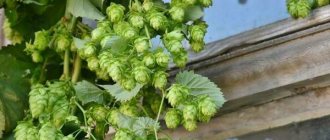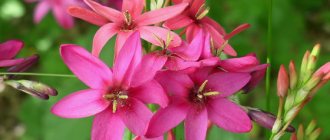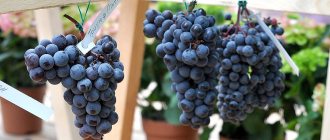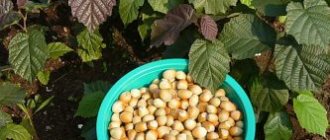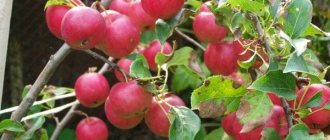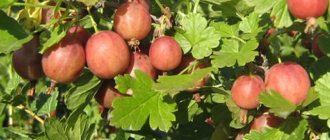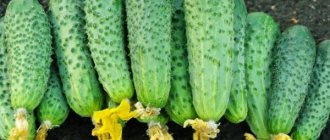Grandmother's granddaughter F1 is a cucumber that is popular among professional and amateur gardeners. When describing its main characteristics, emphasis is placed on fertility and versatility of use. However, before you start cultivating a vegetable, you should familiarize yourself with its external signs, cultivation rules, negative and positive aspects.
Description
The hybrid cucumber Grandmother's grandson was bred by crossing two varieties with early ripening periods . The vegetable was officially included in the State Register in 2012.
The culture belongs to the parthenocarpic (self-pollinating) type. Each flower consists of stamens and pistil. Cucumbers are cultivated in open ground and greenhouse conditions.
The ripening period is early: 38–42 days pass from the emergence of seedlings to harvesting.
The fruits themselves have an attractive presentation; they can easily withstand transportation, maintaining their beneficial properties and unchanged composition. Suitable for growing for sale.
Distinctive features
The hybrid Grandmother's granddaughter f1 has a bouquet type of flowering (more than 3 ovaries are formed in one node).
Other characteristic features of the culture:
- high yield, 2-3 times higher than similar varieties;
- formation in each node from 5 to 12 ovaries;
- resistance to temperature changes;
- limited growth of side shoots;
- resistance to powdery mildew, cladosporiosis and root rot;
- the location of the fruits in the node is from 2 to 4.
Cucumber takes up little space on the site: 3–5 plants are placed per 1 m2.
SIZE OF CUCUMBERS VARIETY Grandmother's granddaughters and Baby's robust
Composition and benefits
The hybrid contains many useful substances:
- vitamins - C, A, PP, B1, B2, beta-carotene;
- trace elements - zinc, iron, potassium, manganese, magnesium, iodine, copper, folic acid, chromium, sodium, chlorine, phosphorus.
Cucumber is easily absorbed by the body, as it consists of 90% structured water. It improves the condition of the thyroid gland, prevents urolithiasis, varicose veins, disorders of the cardiovascular system, and reduces the content of harmful cholesterol in the blood. Removes waste, toxins and heavy metal salts from the body.
Fruits mainly consist of fiber, which is easily and quickly digested. The calorie content of cucumber is low - 15 kcal per 100 g; it is added to the daily diet during a diet and a healthy diet.
Characteristics of bushes and fruits
Medium height hybrid. The branches grow sparsely. The leaves are deep green and medium in size. Female type flowers.
Fruit characteristics:
- oval-cylindrical shape, slightly shortened;
- length - 9–11 cm;
- weight - 75–115 g;
- diameter - up to 2.5 cm;
- the color is uneven: dark green at the base and lighter closer to the top;
- fruits with longitudinal yellow stripes and noticeable spotting;
- the skin is covered with tubercles and light spines;
- the pulp is light green in color with a dense structure;
- when bitten, the fruits produce a characteristic crunch;
- the taste is pleasant without bitterness;
- the aroma is refreshing;
- seed chambers are small.
The yield of the hybrid is high: 11-12 kg per 1 m2.
Features of agricultural technology
Before planting seed material, you need to inspect it, separate small grains and those that are damaged, empty inside, or rotten. They will not give results. Next, the seeds are processed using a 3% manganese solution, soaking is done for half an hour. The seeds are transferred to a growth stimulator, carefully following the instructions for use.
Note!
For planting, you should take peat pots or a longitudinal box. When planting in open ground, containers are not needed.
To grow healthy seedlings you need to purchase soil from a specialized store or prepare it yourself using:
- compost;
- peat;
- humus;
- sand.
Might be interesting Growing cucumbers on a windowsill and balcony Cucumber variety Temp: cultivation, planting and care, photo Planting cucumber seedlings in a greenhouse: how to plant and care
For grains, prepare holes 2-2.5 cm deep. When sowing in containers, it is important to observe a number of points:
- The container must be covered with plastic wrap.
- A stable temperature of +25+30 °C is required.
- A daylight period of 14 hours is required, for which a phytolamp is installed.
- Every day you need to open the film and spray the soil with a spray bottle.
When planting in open ground you need:
- wait until a stable soil temperature of about +13+15 oC is established;
- choose a period when there will be no frost;
- make rows with a distance of 50 cm between them;
- plant 2 seeds in 1 hole;
- Make 30 cm between holes.
If there is a possibility of a decrease in night temperature, then a film covering is constructed over the plantings. Transplantation of seedlings from a container to a breast is done 2 weeks after 2-3 true leaves have formed.
How to grow your own
The hybrid is intended for independent cultivation on a personal plot. Sowing time: from late April to early May.
The quality of the harvest depends on compliance with the rules for preparing seeds, planting crops in the ground and caring for young plants.
Planting by seed and seedling methods
Before planting, the seeds are inspected: the smallest and most damaged ones are separated. They are not usable.
Afterwards the material is processed:
- placed in a 3% solution of potassium permanganate for 20–30 minutes for disinfection;
- then placed in a growth stimulator, according to the attached instructions.
Plant the seeds in small containers (peat pots or longitudinal boxes) or directly into the ground.
For the seedling method, the soil is purchased from a specialized store or prepared independently by mixing compost, peat, humus and sand. The grains are buried 2–2.5 cm.
When planting in containers, observe the following nuances:
- the container is covered with a plastic bag;
- maintain a stable temperature - +25...+30 °C;
- illuminated for more than 12–14 hours, for which phytolamps are additionally installed;
- open the containers daily and spray the soil with a spray bottle.
Requirements for planting in open ground:
- wait for a stable soil temperature of about +13...+15 °C (there should be no night frosts);
- make rows with a distance of 50 cm;
- Place 2 seeds per hole, plant them every 30 cm.
If there is a possible decrease in night temperature, a film shelter is built over the landing site.
Attention! Seedlings are transplanted from containers into open ground after 2 weeks, when 2-3 leaves appear.
Growing and care
After 5-6 days, the first shoots should appear. If the seedlings are in a greenhouse, then the room is opened for several hours a day to allow oxygen to enter and maintain air humidity at a normal level.
When growing, adhere to a number of recommendations:
- water the bushes only with warm, settled water in the morning or evening - on hot days, irrigate the seedlings 2 times a day;
- It is advisable to remove weeds and loosen the soil every time you moisten;
- the soil is periodically hilled up, the loosened soil is sprinkled onto the stems of plants, this will ensure their stability and better development of the root system;
- As the hybrid grows, the stem is tied to wooden posts with cotton tape or twine, preventing the stem from being pulled over.
Feeding is applied several times at different stages of growth:
- 10–14 days after transplantation;
- during flowering;
- during the fruiting period.
Organic fertilizers are used: ammonium nitrate, potassium preparations and superphosphate. The product is diluted in water and poured directly under the root. Make sure that the solution does not get on the leaves or stem of the crop.
Features of cultivation and possible difficulties
Cucumber is grown in any soil where there is drainage and good aeration. However, the soil should be light and rich in humus.
In order for the hybrid to grow better, it is not planted in the same place every season in a row. They wait 4 years. Good predecessors are tomatoes, potatoes, peas and corn, and undesirable ones are strawberries, pumpkin, zucchini, watermelon and melon.
Difficulties in growing crops:
- if water does not seep through well during watering, carefully make several indentations with a rake so as not to damage the roots of the plants;
- to prevent excessive growth of bushes, pinch the main stem after 6-7 leaves have formed;
- If the fruits are picked at the wrong time, they will become overripe and the peel will become rough.
Important! The harvest is collected regularly: several times a week. This stimulates the bushes to form more fruits.
Diseases and pests
The hybrid is resistant to powdery mildew, brown spot, root rot, cucumber mosaic and downy mildew. The crop is practically not attacked by insect pests.
Causes of possible infection:
- abundance of weeds;
- excessive soil irrigation;
- high humidity;
- incorrect crop rotation.
To prevent diseases, the bushes are carefully inspected each time you water. If dark spots, chewed leaves or signs of drying appear, the plants are treated with special means (Fitosporin, Bordeaux mixture, Quadris or Tiram).
Care and agrotechnical advice
“Grandma’s granddaughter f1” needs to be formed and fixed. In the axils of the first 5 leaves, the stems and flowers are removed, then only the shoots are removed. Plants need to be tied to trellises, otherwise the vines will spread along the ground, causing part of the potential harvest to be lost. Flowers and ovaries will fall off from lack of light, and already formed fruits will rot. The plant is tied up when its height is 32-35 cm.
This variety, like other cucumbers, needs watering, hilling, weeding and fertilizing. Water the plants once every 2-3 days with settled water heated to + 22 °C. Watering is carried out at the root in the evening. In extreme heat, cucumbers are watered twice a day - morning and evening. After watering, the plants are earthed up - the wet soil is loosened, sprinkled onto the roots. Weeds are weeded once a week.
Fertilizing is done 3-4 times per season. Mineral fertilizers with potassium, phosphorus, as well as ammonium nitrate fertilizer are applied under the roots. Organic fertilizers are also used, for example, mullein diluted in water. Foliar feeding is also used, especially in cold summers. For it, a spray bottle is used, with which a solution of nutrients is sprayed onto the leaves (this should be done when there is no wind or rain, so that the fertilizing does not blow away or wash away). Most often, urea is used for foliar feeding (10 g diluted in 10 liters of water). Seedlings that have just been planted in the ground are sprayed with it, then spraying is repeated after 15-20 days.
To prevent diseases, you need to inspect the leaves and stems of plants daily. If black or gray spots, gnawed by insects or wilted leaves are found, the cucumbers will have to be treated with disinfectants such as Fitosporin.
Important!
It is necessary to strictly follow the instructions on the packaging of the fungicide, and apply safety measures - prepare mixtures and handle plants using gloves and safety glasses.
The fruits of “Grandma’s granddaughter f1” are collected daily or every other day so that they do not overgrow, and it is advised not to pick them, but to cut them with a sharp knife. The harvest continues until the end of July. When fruiting ends, the cucumber stems are removed and the soil is fertilized.
Harvesting and application
Vegetables are harvested throughout the season. They are used for fresh consumption, added to salads and various dishes, canned, pickled and salted.
The hybrid is grown on an industrial scale on farms. The harvested crop is sold at retail and canned at enterprises.
Prevention and control of diseases and pests
To protect cucumbers from insect pests, film covers are used, which are removed only at the time of flowering (this gives insects the opportunity to pollinate the flowers). Pests can be controlled using special traps: they are equipped with a sticky layer and smell of pheromones, attracting males.
In this way, pests are intercepted before they can cause harm to the plantation. Currently, there are more than a hundred different pheromones that were created specifically to effectively combat specific types of insect pests. The variety is resistant to major fungal diseases.
But for prevention, plants are treated with a 1% solution of Bordeaux mixture before flowering. The active substance of the solution is copper ions. They create a special protective layer on plant tissues, which neutralizes pathogenic microflora. If the weather is dry, then re-treatment is not necessary. But if it rains, then spraying with Bordeaux mixture needs to be done again.
Did you know? If your plantations are attacked by pests, place several pieces of cucumber in an aluminum form. Entering into a chemical reaction, it emits an odor that effectively repels pests from crops, but which is not perceived by people.
Advantages and disadvantages
Grandmother’s grandson has a wide range of advantages, including:
- self-pollination;
- outdoor and greenhouse cultivation;
- resistance to temperature changes;
- fruit collection throughout the season;
- high productivity;
- resistance to diseases characteristic of the culture;
- low maintenance requirements;
- excellent taste of vegetables and healthy composition;
- versatility in application;
- preservation of fruits, their sale.
The plant has practically no disadvantages. They only note sensitivity to drying out of the soil and roughening of the skins of vegetables when overripe.
Important! To preserve their presentation, cucumbers are not picked, but carefully cut with a sharp garden tool.
Planting and growing
Cucumbers are sown in open ground 1–2 weeks after the last spring frost.
The second batch of seeds can be sown a month after the first. In regions with cool summers, planting begins with growing seedlings 3 weeks before planting in the ground. At a temperature of +20°C and a humidity of 60–70%, cucumbers will germinate in 3–5 days. For planting in the ground, choose a sunny area with fertile and well-drained soil with a pH of 6.0 to 6.5. Plants are planted on hills located at a distance of 1.5–2 m from each other.
Cucumber planting scheme.
For planting you will need:
- remove all stones, sticks or other debris from the area;
- dig up the area;
- mix the soil with a bucket of humus or other organic fertilizers;
- water the soil before planting seeds or seedlings.
Growing cucumbers in a greenhouse is quite simple - they will need frequent watering. Seeds are sown from April to May. The soil is dug up and disinfected by treating with boiling water and a solution of copper sulfate 7%. Be sure to apply organic fertilizers.
Important! Seeds are always stored at room temperature and for no more than 2 years. In other situations they begin to lose viability
Plants will need a vertical or horizontal trellis to form the bush. When the seedlings reach the maximum height of the trellis, pinch the apical bud to begin branching the vine: in this way you can slightly increase the yield of the vines.
Forming a cucumber.
Reviews
Vegetable growers note the high yield of the hybrid, ease of care and excellent taste of the fruit.
Anastasia, Voronezh : “I planted Grandma’s granddaughter for the first time. First in pots, then in the garden. It began to bear fruit quickly; all I had time to do was pick crispy cucumbers. I’m very pleased.”
Vladimir, Kursk: “This is not the first year I have been planting. I like that I collect several kilograms from each bush. During the season I am fully supplied with cucumbers. They have a pleasant taste and no bitterness at all. I’ve never encountered any illnesses.”
Maria, Kislovodsk: “Every year I spend the summer at the dacha. I have been growing this hybrid for the third year in a row. It doesn’t need special care - I just tie it up, water it and weed it on time. I close the remaining harvest for the winter. I’ll be provided with delicious cucumbers all year round.”
Characteristics of cucumbers of the Babushkin Vnuchok variety
When growing cucumbers on their plot or greenhouse, it is important for gardeners to choose a variety whose fruits can fully justify the time and effort spent on it. The cucumber variety Babushkin grandson has proven itself quite well.
Characteristics of cucumbers of the Babushkin Vnuchok variety
Characteristics of the variety
The cucumber variety Vnuchok is a hybrid of an early ripening group of plants. It can be grown both in open areas and in greenhouse conditions. This is due to the fact that the Vnuchok cucumber marked f1 is a parthenocarpic hybrid, that is, it does not require pollination by bees for fruiting.
Biologists classify this varietal variety as a representative of plants with a female flowering type. The fruits ripen within 38-40 after the first shoots appear. Cucumbers of this variety are considered suitable for commercial sale.
The yield indicators of the f1 hybrid are quite high. One hectare of bushes brings from 374 to 469 centners of harvest. At the same time, the yield of marketable products is 80-96%, which is a very high figure.
The varietal variety is universal in its application. The collected fruits are suitable:
- For fresh consumption.
- For pickling.
- For pickling and preservation.
Description of the bush
Cucumbers Grandmother's granddaughter f1 are medium-sized plants. The branching of the bush is also at an average level. The description of the culture also states that our variety is indeterminate. This means that the whip grows without being limited to the flower cluster.
The leaf cover of the bushes is medium in size. Leaf color is green. According to materials from biologists, a bouquet-type ovary is formed on the bushes of this varietal variety.
Description of the fruit
As mentioned earlier, the fruits of this variety of cucumber crop are suitable for commercial sale. This is due to their external and taste characteristics.
The shape of greens of this variety is oval-cylindrical, the tubercles on the surface are small. The size of the fruits does not exceed 7-9 cm, and the weight of each fruit reaches about 65-80 grams. The length of the greens and its diameter are in a ratio of 3:1.
The skin of the fruit is green at the base and lighter at the top. The surface of the fruit has dense pubescence with white spines. There are also longitudinal stripes of white color, which are clearly visible on a third of the fruit, after which they become more blurred. There is also a distinct spotting on the skin.
The flesh is greenish in color and crispy. There is no bitterness in the taste. The chamber in which the seeds are located is small.
It is precisely this combination of qualities and characteristics that has made this hybrid variety so popular among farmers and gardeners. An equally important role was played by the good keeping quality of the fruit, which has a positive effect on commercial quality.
Growing
The plant requires good care
In order for a crop to bring maximum yield, it is important to plant it correctly and care for it. This is the only way to obtain high-quality fruits from ordinary seed material.
Seeds are usually planted for seedlings in April or early May. Sprouts are transplanted to open areas at the end of May or beginning of June. It is necessary to plant seedlings at the stage of 2-3 true leaves. Planting material is placed under temporary shelters made of film material. Seedlings are planted according to the 50x50 pattern, that is, the distance between the bushes should be at least 50 cm.
Caring for the plant while growing on the site includes standard measures, namely:
- Hilling.
- Weeding.
- Watering the plant in the evening.
Experienced gardeners say that if the weather is too hot, it is worth watering the plants twice a day - in the morning and in the evening. It is also recommended to cut the fruits at the time of picking. This avoids unnecessary damage to the plant.
Disease resistance
This varietal variety of cucumber is quite disease-resistant. Many experienced gardeners claim that this cucumber is not afraid of the main diseases that affect the crop. This is another factor influencing the popularity of the variety.
The resistance of the variety extends to the following pathogenic processes:
- Powdery mildew.
- Root rot.
- Brown spot.
- Cucumber mosaic virus.
The culture is also tolerant to peronospora. Such natural properties of the variety make caring for it somewhat easier, which is also good for farmers.
Conclusion
Early ripening cucumbers Grandmother's grandson are very popular among gardeners due to the good marketability and taste characteristics of the fruit, good keeping quality, ease of care and high resistance to disease. No less important is the high yield of this variety, bred by domestic breeders.

